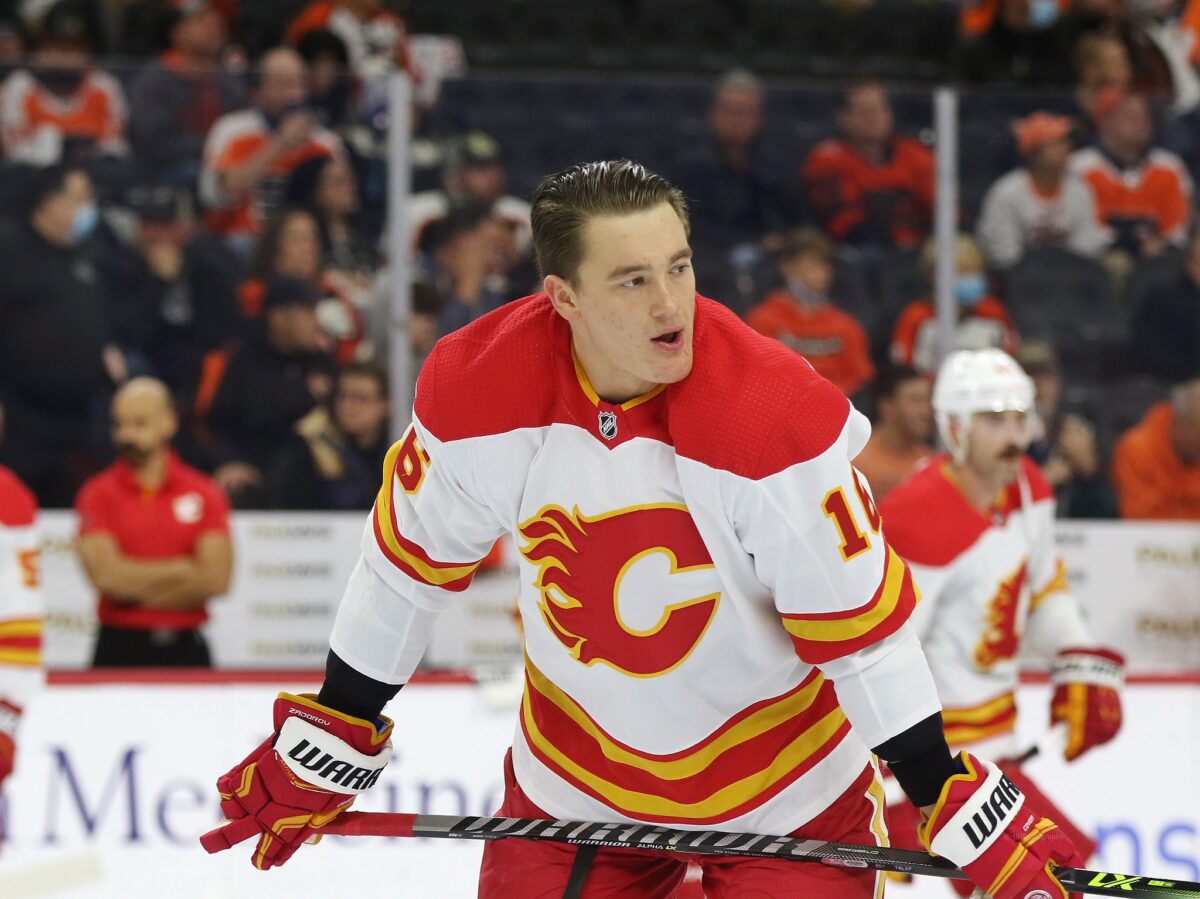When Calgary Flames’ general manager Brad Treliving made an offseason trade with the Chicago Blackhawks for Nikita Zadorov, many were left scratching their heads. At the time it seemed as though the Flames left side defence was spoken for with Noah Hanifin, Oliver Kylington, and Jusso Valimaki looking for jobs. Zadorov however has become part of Calgary’s third pairing, pushing Valimaki to the American Hockey League.

The big Russian blueliner has been known to be a tough customer and a defensive defenceman with not much of an offensive game. He has come as advertised this year doling out big hits more so than points. Although in the last month, Zadorov has really started to stand out for some fans and has even impressed in the offensive zone.
Zadorov by the Numbers
He has been on the Flames’ third pairing for the whole season and has been playing other teams’ bottom rotation forwards but has some of the best numbers amongst the defence. His 58.36 Corsi for (CF%) and 55.84 expected goals for (xGF%) rank him first and second respectively among Calgary’s blueliners. Zadorov has especially been turning the corner since the start of 2022, in the 12 games in January he posted a combined CF% and xGF% below 50% just twice.
Zadorov has not been known for his offensive abilities as last season he posted 8 points in 55 games with the Blackhawks even in a top-four role. This season he has already surpassed that with nine points in 35 games. His last goal came against the St. Louis Blues when he took a pass from Matthew Tkachuk and walked in releasing a rocket of a shot.
This season he is currently on pace for 22 points which would be a career-high for him. He is currently fourth amongst the Flames’ defence in scoring with nine points in 35 games and eight of them have come at five on five. Hanifin, Rasmus Andersson and Chris Tanev all have nine points at five on five but have all played around 150 more minutes than Zadorov.
The Scouting Report
In the early part of the season, Zadorov looked somewhat slow and was easily susceptible to taking himself out of the play trying to make a big hit. More recently he has made some punishing hits but hasn’t completely taken himself out of the play.
Related: Flames Weekly: Streaky Offence, Markstrom Shutouts & More
When Zadorov gets moving on the ice he can really wind it up, even looking quite fast at times when he’s carrying the puck. He doesn’t have the acceleration like a Kylington, but he can dipsy-doodle around other teams and has got more confident with the puck in recent games. He possesses a hard and quick shot which is how he has scored all three of his goals this season.
Flames’ fans can definitely appreciate the blueliner when he makes certain big hits as he did against Darnell Nurse at the last installment of the battle of Alberta.
When he uses his large frame to take out opponents but doesn’t completely take himself out of the play he can be very effective. Going into the rest of the season the Flames will need Zadorov to continue to punish opponents while being solid in his own end.
Zadorov’s Contract Not as Much of an Overpay
When Zadorov signed with the Flames on a one-year $3.75 million contract, it was a tough pill to swallow against the cap. At that price, he is one of the highest-paid third-pairing defencemen in the league. But his play of late has made him worth most of the contract as among defencemen to play 200 minutes he is second in the NHL in CF% and 23rd in xGF%.
You may also like:
- Every NHL Team’s Most Underrated Prospect
- Calgary Flames: 5 CHL Free Agents Worthy of a Closer Look
- NHL Rumors: Canucks, Capitals, Oilers, Flames, Maple Leafs
- NHL Rumors: Flames, Flyers, Canucks, Canadiens
- Calgary Flames: 4 Other College Free Agents Worth Looking At
Having players like Valimaki and Connor Mackey both knocking on the door for NHL time it’s not a given that Zadorov will be back next season. But in the past month, he has shown that he can be a very capable stay-at-home defenceman in the role he has been given. After a tough 2020-21 season in Chicago playing in their top-four, Zadorov has found a home on the Flames’ third pair and has been giving Darryl Sutter much-needed stability when their top two pairs need a rest.